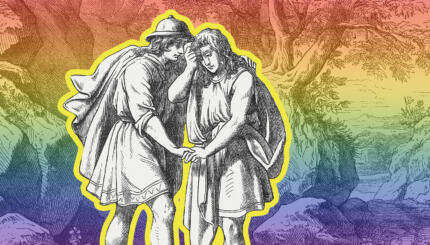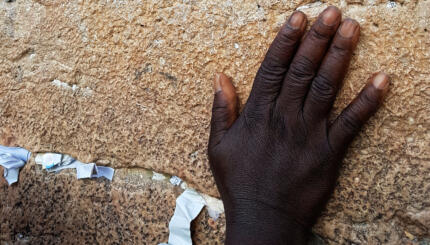The following article is reprinted with permission from JewishFamily.com, published by Jewish Family & Life.
Born Jewish in 1933, I was a feminist activist at two. By 24 I had fulfilled society’s mandate: "get married, have children and live happily ever after," except that I was divorced by 44. At 45 1 had my first lesbian relationship and at 59 discovered Congregation Beth Simchat (CBST), New York City’s synagogue for gay and lesbian Jews. I did not come out to my children until I was 60.
By 60, I’d had two lesbian relationships: the first, closeted, was almost as bad as my marriage; the second, also closeted but more fulfilling, lasted eight years. While recovering from that relationship, I read about the pending installation of Rabbi Sharon Kleinbaum, a lesbian feminist, as the first rabbi at CBST. I went. I was awed hearing "gay" and "lesbian" used in the same sentences as "Jewish," and all said with pride. At the installation, I learned about a monthly Feminist Minyan and went the next week. Three months later, I went to the Minyan and asked to read a prayer I had written on the death of a friend. I have been writing prayers and developing services at CBST ever since.
I was "adopted" by young Minyan members, who dubbed me "baby dyke" and introduced me to lesbian literature, music, hangouts and PRIDE celebrations. At the same time, they immersed me in Judaism. One new friend, knowing of my closeted lifestyle, brought me a brochure for Elat Chayyim, the Jewish Renewal Retreat Center. They were having a week’s course, "Twice Blessed: Being Gay and Jewish." I went. I was "out" from the start in that class, and I found there a new freedom; a release from pain I hadn’t even recognized till then. I knew I had to come out to my children, especially my daughter, who I hoped would someday share the Elat Chayyim experience with me.

Help us keep Jewish knowledge accessible to millions of people around the world.
Your donation to My Jewish Learning fuels endless journeys of Jewish discovery. With your help, My Jewish Learning can continue to provide nonstop opportunities for learning, connection and growth.
The following week I went to see my daughter, and with my heart in my mouth, blurted out, "I had a wonderful time. I was out all week. I’m a lesbian." "Whew," she said, "We’ve wanted to talk to you about it for eight years." I realized then how much I had underestimated my children’s intelligence, and by closeting myself, I had robbed myself of their support and comfort.
Since that time I have been on a journey of fulfillment as a Jewish-lesbian‑grandmother‑feminist‑activist. Until my sixties, I was all that, but fragmented. Since 60 I have evolved from a "Revolving Door Jew"–in on Rosh Hashanah, out on Yom Kippur–to one who welcomes Shabbat, studies Torah, relishes my Judaism. Today I ask is it the "Jewish" or the "lesbian" part of me that provides the glue that makes it happen?
In my earlier activist life, I had a different relationship to Judaism. On the board of the Older Women’s League, a national education and advocacy organization for midlife and older women, I raised both Jewish and lesbian awareness while out as a Jew, closeted as a lesbian. Today, I work with SAGE, Senior Action in a Gay Environment, as a Jewish lesbian, growing older, fighting ageism. I do not attend conferences on Shabbat, and I explain why I don’t.
At CBST I advocate for more time at the bimah (podium) for older lesbians who were denied that time in their young girlhood. At this special synagogue I have the opportunity to extend the breadth of feminist Judaism. I began a bimonthly service using Marcia Falk’s innovative Book of Blessings.We actively seek out women who at 30, and 40, and even 50, are justlearning to leyn (read) Torah.
Each Friday I study Torah at Ma’yan, the Jewish Women’s Project, with a group of women of diverse Jewish backgrounds. Our brilliant young teacher, who is grounded in both feminism and traditional Judaism, nurtures my growing appreciation of Judaism. She encourages my struggles with texts and halachah (Jewish law), and my questioning whether [certain] texts should be expunged–or at the very least looked at through a different lens which asks: How has this text hurt women? Has Judaism acknowledged that hurt? What in Judaism works to heal that hurt and see that it does not continue to be abusive? At CBST I have the opportunity to develop drashot (interpretations of the biblical text) using that lens.
Although I’m a "baby dyke" and a new student of Torah, I bring to the table 65 years of experience of activism, of expanding boundaries, searching for ways to integrate my life experiences. I bring my administrative and activist experience to the Boards of CBST and the World Congress of Gay, Lesbian and Bisexual Jewish Organizations. As I approached my 65th birthday, my Ma’yan teacher helped me develop a ceremony celebrating that milestone in a way that allowed me and those with me to harvest our lives and celebrate mine as a Jewish‑feminist‑lesbian‑grandmother activist, who relishes the adventure of growing older.


